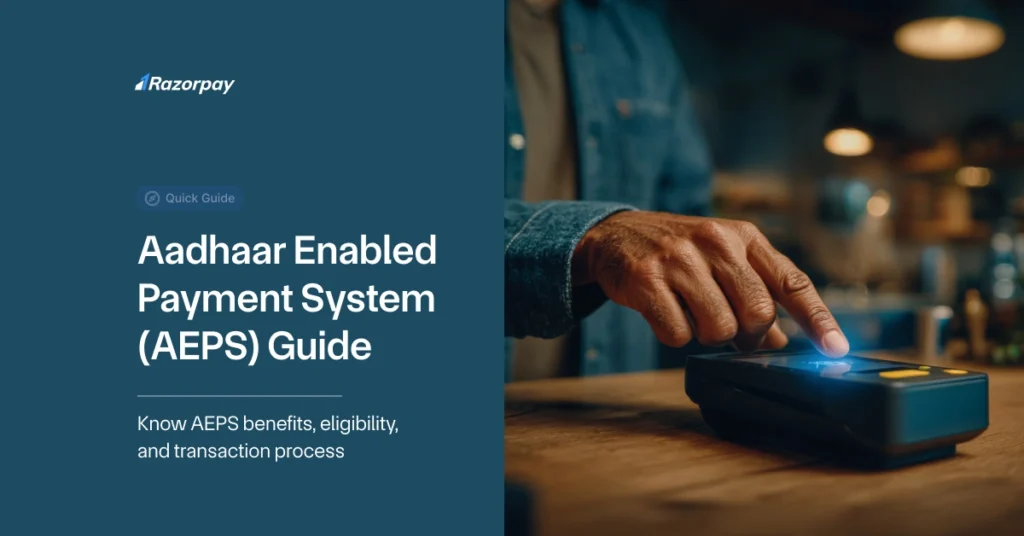The introduction of the digital payment system was a revolutionary chapter in India’s financial history, combining convenience and reliability. Since its inception, the digital payments system in India has undergone several updates, each aimed at making it more reliable, robust and accessible to the less developed communities within the country. The Aadhar Enabled Payment System, or AePS, is one such initiative by the top financial institutions to promote financial inclusion. In this article, we discuss AePS in detail and how Razorpay includes the AePS as part of it’s payment facilitation.
Key Takeaways
Aadhar-enabled Payment System, developed by the NPCI (National Payments Corporation of India) is a novel initiative aimed at financial inclusion. With AePS, customers can perform banking transactions using only their Aadhar card details.
Razorpay has integrated AePS service, enabling retailers from underdeveloped regions of India to conduct transactions without going through the hassle of using bank-specific apps or credit/debit cards.
What is AePS?
The Aadhar enabled Payment System is a bank-led model facilitating secure, online interoperable financial transactions at any of the PoS, which are micro-ATMs in most cases, through business correspondents in any of the NPCI-approved banks. An Aadhar-based payment system ensures smooth transactions without compromising customer security. It was developed by the National Payments Corporation of India (NPCI), under the aegis of the RBI. The system enables customers to conduct basic banking transactions with the help of –
- Bank Name
- Aadhar Number
- Biometrics captured during enrollment
Encouraging people to use Unified Identification Number as the primary source of identification and transaction was the major motivation behind this initiative. This new step has enabled customers – especially businesses, to use banking services without having to rely on financial aids like cards and passbooks.
How Does It Work?

A customer can walk into any of NPCI’s partner banks to use AePS. Here is a step-by-step explanation of how it works.
- A customer uses a micro-ATM device or approaches a banking correspondent at any of NPCI’s partner banks(agent).
- The customer provides their Aadhaar number and selects their bank.
- The desired transaction (cash withdrawal, deposit, fund transfer, balance enquiry, etc.) is chosen.
- Biometric authentication (typically fingerprint, sometimes iris scan) is performed using a biometric device connected to the micro-ATM.
- The UIDAI system verifies the biometric.
- Upon success, the transaction is processed, and the customer receives confirmation and a printed receipt.
When you transact using the AePS, the system makes use of biometric authentication to validate the transaction. This ensures that no one else can access your details. In addition to that, here are a few other key features of using the AePS for transactions.
- No debit/credit card or PIN is required; only Aadhaar number and biometric authentication.
- Enables multiple banking services: cash withdrawal, deposit, balance enquiry, fund transfers, and mini statements.
- Transactions are interoperable across banks—any bank’s customer can transact at any AePS-enabled micro-ATM.
- Biometric authentication ensures robust transactions, leaving very little room for fraud.
- Designed to drive financial inclusion in rural and underserved areas where traditional banking infrastructure is limited.
Who Can Use AePS?
If you possess an Aadhar card and your Aadhar number is linked to your bank account, you are eligible to transact using the AePS. As mentioned above, one of the major reasons behind developing this system was to encourage customers to use their Aadhar card not just for identification purposes but also to conduct banking transactions without having to carry several bank documents. In addition to transactions, customers can also avail an array of different banking services with just one card.
Here is a list pre-requisites that customers must fulfill to complete an Aadhar based transactions.
Aadhaar Requirement: The user must possess a valid Aadhaar number.
Aadhaar-linked Bank Account: The bank account must be linked to the user’s Aadhaar number. Transactions are only possible through such linked accounts.
Biometric Verification: Customers must be able to provide biometric authentication (usually fingerprint) at the transaction point.
Razorpay And AePS: How Razorpay Helps Retailers With This Feature?
Razorpay is the preferred payment gateway for several businesses – big and small. Its ecosystem has evolved to incorporate Aadhar-based payment transactions, making it a hassle-free task. This is beneficial especially for rural businesses located in places with limited or no access to regular banking services. Benefits for Businesses and Users. Through the Razorpay Partner Program, several businesses have access to the aadhar payment system, facilitating seamless transactions.
Seamless Experience With Razorpay: Users can use Aadhaar-linked accounts for secure, cashless payments—avoiding the need for cards or manual bank details—with high transaction success and ease of use, particularly for government- or utility-related services.
Innovation in Financial Inclusion: AePS enables broader access to digital financial services in rural and semi-urban India, and integrations like those by Razorpay help democratize access to these payment options for a wider set of users.
Although the system is not entirely foolproof, AePS has managed to connect several populations across India to a seamless, secure and flexible banking experience.
Conclusion
The NPCI has realised the idea of a unified source of authentication for banking transactions with Aadhar based payment systems, making secure banking accessible to remote populations throughout India. With AePS integration, payment gateways like Razorpay have successfully facilitated seamless banking transactions for businesses. Since the system is new, it is being rolled out in phases, to ensure end-to-end robustness and accuracy. Although it is secure, it is not foolproof. Hence, it is imperative that organizations must follow best-practices and use the system with necessary precautions while doing so.
FAQs
What is the difference between the Aadhaar-enabled Payment System and UPI?
Aadhaar-enabled Payment System encourages consumers to use their Aadhaar card to authenticate simple banking transactions online. This reduces reliance on other aids such as bank passbooks and ATM cards. In AePS, consumers can perform banking transactions using their Aadhaar card for authentication. UPI stands for Unified Payments Interface, a platform which facilitates digital transactions to merchants securely through applications. UPI transactions can be undertaken anywhere.
Do I need a smartphone for AEPS transactions?
Not necessarily. AePS transactions can be done using micro-ATMs or by getting in touch with Business Correspondents in any of the NPCI-approved banks.
Can I use AEPS without linking Aadhaar to my bank account?
No, To be able to use the AePS, your Aadhaar card number must be linked to your bank account.
Is AEPS safe and secure for banking?
AePS is one of the safest ways for banking. Biometric authentication requires consumers to be physically present in the bank while conducting their business which makes this method less susceptible to instances of fraud and financial scams. However, it is still in its infancy hence consumers must adhere to best practices while using it.


